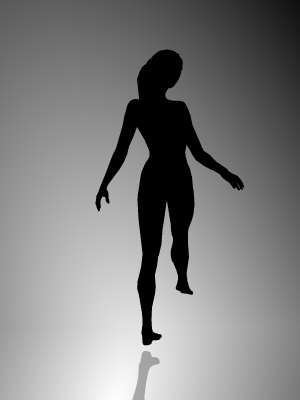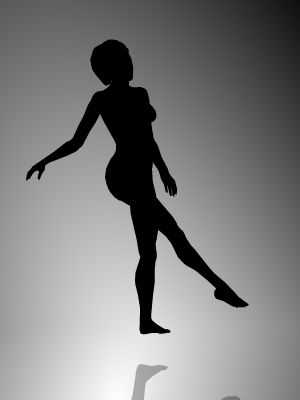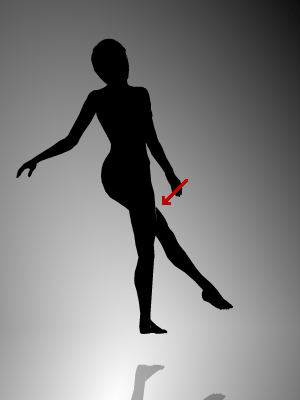This Spinning Silhouette optical illusion is making the rounds on the internet this week, and it’s being touted as a “right brain vs left brain test.” The theory goes that if you see the silhouette spinning clockwise, you’re right brained, and you’re left brained if you see it spinning counterclockwise.
Everytime I looked at the damn thing, it was spinning a different direction. I closed my eyes and opened them again, and it spun a different direction. Every now and again, and it would stay the same direction twice in a row, but if I looked away and looked back, it changed direction. Now, if I focus my eyes on a point below the illusion, it doesn’t seem to rotate all the way around at all, instead it seems like she’s moving from one side to the other, then back (i.e. changing directions every time the one leg reaches the side of the screen – and the leg always seems to be in front of the silhouette).
Of course, this is the essense of the illusion. The silhouette isn’t actually spinning at all, because it’s two dimensional. However, since my brain is used to living in a three dimensional world (and thus parsing three dimensional images), it’s assuming that the image is also three dimensional. We’re actually making lots of assumptions about the image, and that’s why we can see it going one way or the other.
Eventually, after looking at the image for a while and pondering the issues, I got curious. I downloaded the animated gif and opened it up in the GIMP to see how the frames are built. I could be wrong, but I’m pretty sure this thing is either broken or it’s cheating. Well, I shouldn’t say that. I noticed something off on one of the frames, and I’d be real curious to know how that affects people’s perception of the illusion (to me, it means the image is definitely moving counterclockwise). I’m almost positive that it’s too subtle to really affect anything, but I did find it interesting. More on this, including images and commentary, below the fold.
First thing’s first, here’s the actual spinning silhouette.

Again, some of you will see it spinning in one direction, some in the other direction. Everyone seems to have a different trick for getting it to switch direction. Some say to focus on the shadow, some say to look at the ankles. Closing my eyes and reopening seems to do the trick for me. Now let’s take a closer look at one of the frames. Here’s frame 12:

Looking at this frame, you should be able to switch back and forth, seeing the leg behind the person or in front of the person. Again, because it’s a silhouette and a two dimensional image, our brain usually makes an assumption of depth, putting the leg in front or behind the body. Switching back and forth on this static image was actually a lot easier for me. Now the tricky part comes in the next frame, number 13 (obviously, the arrow was added by me):

Now, if you look closely at the leg, you’ll see a little imperfection in the silhouette. Maybe I’m wrong, but that little gash in the leg seems to imply that the leg is behind the body. If you try, you can still get yourself to see the image as having the leg in front, but then you’ve got this gash in the leg that just seems very out of place.
So what to make of this? First, the imperfection is subtle enough (it’s on 1 frame out of 34) that everyone still seems to be able to see it rotate in both directions. Second, maybe I’m crazy, and the little gash doesn’t imply what I think. Anyone have alternative explanations? Third, is that imperfection intentional? If so, why? It does not seem necessary, so I’d be curious to know if the creators knew about it, and what their intention was regarding it.
Finally, as far as the left brain versus right brain portion, I find that I don’t really care, but I am interested in how the imperfection would affect this “test.” This neuroscientist seems to be pretty adamant about the whole left/right thing being hogwash though:
…the notion that someone is “left-brained” or “right-brained” is absolute nonsense. All complex behaviours and cognitive functions require the integrated actions of multiple brain regions in both hemispheres of the brain. All types of information are probably processed in both the left and right hemispheres (perhaps in different ways, so that the processing carried out on one side of the brain complements, rather than substitutes, that being carried out on the other).
At the very least, the traditional left/right brain theory is a wildly oversimplified version of what’s really happening. The post also goes into the way the brain “fill in the gaps” for confusing visual information, thus allowing the illusion.
Update: Strange – the image appears to be rotating MUCH faster in Firefox than in Opera or IE. I wonder how that affects perception.
That’s pretty much mind-blowing. I can’t figure out how I change my perception, but I do. It’s really weird putting the IE and Firefox ones on the same screen – I can convince myself that one of them is spinning in the opposite direction as the other. It takes conscious will and time for me to shift what I see, though.
Ben